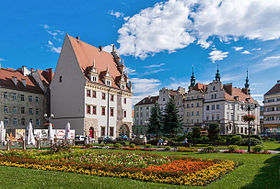Neisse (town)
| Nysa | |||
|---|---|---|---|

Main Square
|
|||
|
|||
| Nickname(s): Śląski Rzym Silesian Rome |
|||
| Coordinates: 50°28′17″N 17°20′2″E / 50.47139°N 17.33389°E | |||
| Country |
|
||
| Voivodeship | Opole | ||
| County | Nysa County | ||
| Gmina | Gmina Nysa | ||
| Established | 10th century | ||
| Town rights | 1223 | ||
| Government | |||
| • Mayor | Kordian Kolbiarz | ||
| Area | |||
| • Total | 27.5 km2 (10.6 sq mi) | ||
| Elevation | 195 m (640 ft) | ||
| Population (31.12.2015) | |||
| • Total | 43,220 | ||
| • Density | 1,600/km2 (4,100/sq mi) | ||
| Time zone | CET (UTC+1) | ||
| • Summer (DST) | CEST (UTC+2) | ||
| Postal code | 48-300 | ||
| Area code(s) | +48 77 | ||
| Car plates | ONY | ||
| Website | http://www.nysa.pl | ||
Nysa [ˈnɨsa] (German: Neisse or Neiße) is a town in southwestern Poland on the Nysa Kłodzka river, situated in the Opole Voivodeship. With 43,220 inhabitants (2015), it is the capital of Nysa County. It comprises the urban portion of the surrounding Gmina Nysa. Historically the town was part of Lower Silesia.
Nysa is one of the oldest towns in Silesia. It was probably founded in the 10th century and afterwards became the capital of a principality of its name, which around 1200 became part of the Bishopric of Wrocław as the Duchy of Nysa. The town's fortifications from 1350 served to defend against the Hussites in 1424. The town and the duchy was part of Lands of the Bohemian Crown in years 1342 - 1742.
During the Thirty Years' War (1618–1648) it was besieged three times. The first Silesian War (1740–41, War of the Austrian Succession) ended Austrian sovereignty over Silesia and left the town in the hands of King Frederick II of Prussia, who laid the foundations of its modern fortifications. On 25 August 1769 Neisse was the site of a meeting between Frederick II and Emperor Joseph II, co-regent in the Habsburg Monarchy of Austria.
During the Napoleonic Wars, Neisse was taken by the French in 1807. It retained its mostly Catholic character within the predominantly Protestant province of Silesia in the Kingdom of Prussia. Because of its many churches from the Gothic and Baroque periods the town was nicknamed "the Silesian Rome". From 1816-1911, the town was the seat of the Neisse District, after which it became an independent city.
...
Wikipedia



